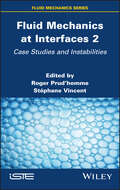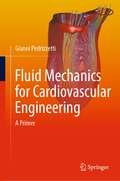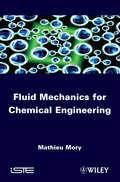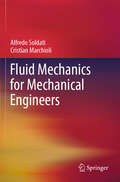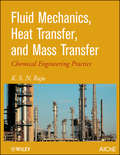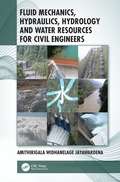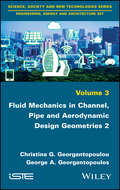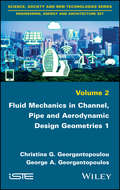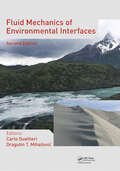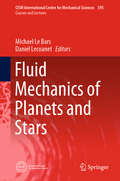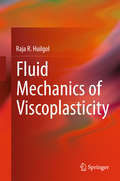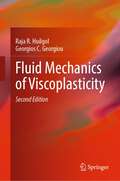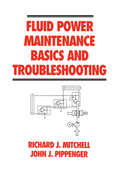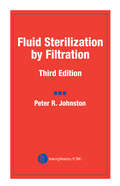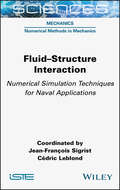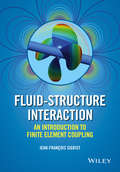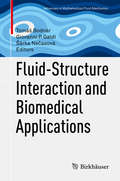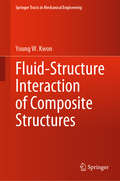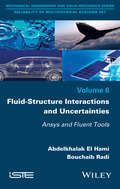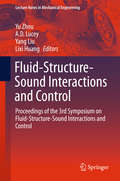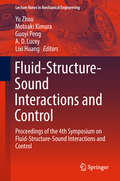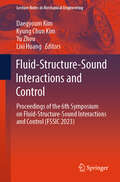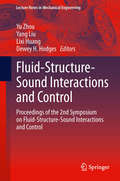- Table View
- List View
Fluid Mechanics at Interfaces 2: Case Studies and Instabilities
by Roger Prud’homme Stéphane VincentInterfaces are present in most fluid mechanics problems. They not only denote phase separations and boundary conditions, but also thin flames and discontinuity waves. Fluid Mechanics at Interfaces 2 examines cases that involve one-dimensional or bi-dimensional manifolds, not only in gaseous and liquid physical states but also in subcritical fluids and in single- and multi-phase systems that may be pure or mixed.Chapter 1 addresses certain aspects of turbulence in discrete mechanics, briefly describing the physical model associated with discrete primal and dual geometric topologies before focusing on channel flow simulations at turbulence-inducing Reynolds numbers. Chapter 2 centers on atomization in an accelerating domain. In one case, an initial Kelvin–Helmholtz instability generates an acceleration field, in turn creating a Rayleigh–Taylor instability which ultimately determines the size of the droplets formed. Chapter 3 explores numerical studies of pipes with sudden contraction using OpenFOAM, and focuses on modeling that will be useful for engines and automobiles.Chapters 4 and 5 study the evaporation of droplets that are subject to high-frequency perturbations, a possible cause of instabilities in injection engines. The Heidmann model, which replaces the droplets in motion in a combustion chamber with a single continuously-fed droplet, is made more complex by considering the finite conduction heat transfer phenomenon. Finally, Chapter 6 is devoted to a study of the rotor blade surface of a Savonius wind turbine, considering both a non-stationary and a three-dimensional flow.
Fluid Mechanics for Cardiovascular Engineering: A Primer
by Gianni PedrizzettiThis book provides a guiding thread between the distant fields of fluid mechanics and clinical cardiology. Well rooted in the science of fluid dynamics, it drives the reader across progressively more realistic scenarios up to the complexity of routine medical applications. Based on the author’s 25 years of collaborations with cardiologists, it helps engineers learn communicating with clinicians, yet maintaining the rigor of scientific disciplines. This book starts with a description of the fundamental elements of fluid dynamics in large blood vessels. This is achieved by introducing a rigorous physical background accompanied by examples applied to the circulation, and by presenting classic and recent results related to the application of fluid dynamics to the cardiovascular physiology. It then explores more advanced topics for a physics-based understanding of phenomena effectively encountered in clinical cardiology. It stands as an ideal learning resource for physicists and engineers working in cardiovascular fluid dynamics, industry engineers working on biomedical/cardiovascular technology, and students in bio-fluid dynamics. Written with a concise style, this textbook is accessible to a broad readership, including students, physical scientists and engineers, offering an entry point into this multi-disciplinary field. It includes key concepts exemplified by illustrations using cutting-edge imaging, references to modelling and measurement technologies, and includes unique original insights.
Fluid Mechanics for Chemical Engineering
by Mathieu MoryThe book aims at providing to master and PhD students the basic knowledge in fluid mechanics for chemical engineers. Applications to mixing and reaction and to mechanical separation processes are addressed.The first part of the book presents the principles of fluid mechanics used by chemical engineers, with a focus on global theorems for describing the behavior of hydraulic systems. The second part deals with turbulence and its application for stirring, mixing and chemical reaction. The third part addresses mechanical separation processes by considering the dynamics of particles in a flow and the processes of filtration, fluidization and centrifugation. The mechanics of granular media is finally discussed.
Fluid Mechanics for Mechanical Engineers
by Alfredo Soldati Cristian MarchioliThis textbook describes the fundamentals of the phenomena of fluid dynamics in the context of engineering instances. It is designed to replace introductory books and notes on the subject for first-level engineering courses as well as higher-level courses or for professional use. The use of this book requires the basic knowledge of mathematics and physics normally delivered in the early years of undergraduate study. However, the extensive use of examples and solved exercises proposes a parallel intuitive route to understanding the necessary mathematical formalisms. It proves that a new fluid dynamics text should not contain new ideas or formalisms, but should present the material in a modern and intuitive way. The approach chosen is primarily practical, so that that readers can practice by solving the proposed problems and examples in order to be prepared to solve the new problems they will encounter in their academic and professional activities. It serves as a teaching tool for coursesin basic fluid dynamics, advanced fluid dynamics, turbulence, and aerodynamics.
Fluid Mechanics, Heat Transfer, and Mass Transfer: Chemical Engineering Practice
by K. S. RajuThis broad-based book covers the three major areas of Chemical Engineering. Most of the books in the market involve one of the individual areas, namely, Fluid Mechanics, Heat Transfer or Mass Transfer, rather than all the three. This book presents this material in a single source. This avoids the user having to refer to a number of books to obtain information. Most published books covering all the three areas in a single source emphasize theory rather than practical issues. This book is written with emphasis on practice with brief theoretical concepts in the form of questions and answers, not adopting stereo-typed question-answer approach practiced in certain books in the market, bridging the two areas of theory and practice with respect to the core areas of chemical engineering. Most parts of the book are easily understandable by those who are not experts in the field. Fluid Mechanics chapters include basics on non-Newtonian systems which, for instance find importance in polymer and food processing, flow through piping, flow measurement, pumps, mixing technology and fluidization and two phase flow. For example it covers types of pumps and valves, membranes and areas of their use, different equipment commonly used in chemical industry and their merits and drawbacks. Heat Transfer chapters cover the basics involved in conduction, convection and radiation, with emphasis on insulation, heat exchangers, evaporators, condensers, reboilers and fired heaters. Design methods, performance, operational issues and maintenance problems are highlighted. Topics such as heat pipes, heat pumps, heat tracing, steam traps, refrigeration, cooling of electronic devices, NOx control find place in the book. Mass transfer chapters cover basics such as diffusion, theories, analogies, mass transfer coefficients and mass transfer with chemical reaction, equipment such as tray and packed columns, column internals including structural packings, design, operational and installation issues, drums and separators are discussed in good detail. Absorption, distillation, extraction and leaching with applications and design methods, including emerging practices involving Divided Wall and Petluk column arrangements, multicomponent separations, supercritical solvent extraction find place in the book.
Fluid Mechanics, Hydraulics, Hydrology and Water Resources for Civil Engineers
by Amithirigala Widhanelage JayawardenaOne of the core areas of study in civil engineering concerns water that encompasses fluid mechanics, hydraulics and hydrology. Fluid mechanics provide the mathematical and scientific basis for hydraulics and hydrology that also have added empirical and practical contents. The knowledge contained in these three subjects is necessary for the optimal and equitable management of this precious resource that is not always available when and where it is needed, sometimes with conflicting demands. The objective of Fluid Mechanics, Hydraulics, Hydrology and Water Resources for Civil Engineers is to assimilate these core study areas into a single source of knowledge. The contents highlight the theory and applications supplemented with worked examples and also include comprehensive references for follow-up studies. The primary readership is civil engineering students who would normally go through these core subject areas sequentially spread over the duration of their studies. It is also a reference for practicing civil engineers in the water sector to refresh and update their skills.
Fluid Mechanics in Channel, Pipe and Aerodynamic Design Geometries
by Christina G. Georgantopoulou George A. GeorgantopoulosFluid mechanics is an important scientific field with various industrial applications for flows or energy consumption and efficiency issues. This book has as main aim to be a textbook of applied knowledge in real fluids as well as to the Hydraulic systems components and operation, with emphasis to the industrial or real life problems for piping and aerodynamic design geometries. Various problems will be presented and analyzed through this book.
Fluid Mechanics in Channel, Pipe and Aerodynamic Design Geometries
by Christina G. Georgantopoulou George A. GeorgantopoulosFluid mechanics is an important scientific field with various industrial applications for flows or energy consumption and efficiency issues. This book has as main aim to be a textbook of applied knowledge in real fluids as well as to the Hydraulic systems components and operation, with emphasis to the industrial or real life problems for piping and aerodynamic design geometries. Various problems will be presented and analyzed through this book.
Fluid Mechanics of Environmental Interfaces
by Sajjan G. ShivaEnvironmental Fluid Mechanics (EFM) studies the motion of air and water at several different scales, the fate and transport of species carried along by these fluids, and the interactions among those flows and geological, biological, and engineered systems. EFM emerged some decades ago as a response to the need for tools to study problems of flow an
Fluid Mechanics of Planets and Stars (CISM International Centre for Mechanical Sciences #595)
by Michael Le Bars Daniel LecoanetThis book explores the dynamics of planetary and stellar fluid layers, including atmospheres, oceans, iron cores, and convective and radiative zones in stars, describing the different theoretical, computational and experimental methods used to study these problems in fluid mechanics, including the advantages and limitations of each method for different problems. This scientific domain is by nature interdisciplinary and multi-method, but while much effort has been devoted to solving open questions within the various fields of mechanics, applied mathematics, physics, earth sciences and astrophysics, and while much progress has been made within each domain using theoretical, numerical and experimental approaches, cross-fertilizations have remained marginal. Going beyond the state of the art, the book provides readers with a global introduction and an up-to-date overview of relevant studies, fully addressing the wide range of disciplines and methods involved. The content builds on the CISM course “Fluid mechanics of planets and stars”, held in April 2018, which was part of the research project FLUDYCO, supported by the European Research Council (ERC) under the European Union's Horizon 2020 research and innovation program.
Fluid Mechanics of Viscoplasticity
by Raja R. HuilgolIn this book, we shall consider the kinematics and dynamics of the flows of fluids exhibiting a yield stress. To highlight the principal characteristics of such fluids, the first chapter emphasizes the role played by the yield stress. Next, a careful description of the continuum mechanics behind the constitutive equations for incompressible and compressible viscoplastic fluids is given in Chapters 2-4. In Chapters 5 and 6 analytical solutions to several steady and unsteady flows of Bingham fluids are presented. The subsequent Chapters 7-10 are concerned with the development of variational principles and their numerical solutions, along with perturbation methods which play a significant role in numerical simulations.
Fluid Mechanics of Viscoplasticity
by Raja R. Huilgol Georgios C. GeorgiouThis book considers the kinematics and dynamics of the flows of fluids exhibiting a yield stress. Continuum mechanics governing the fluid mechanics is described. Two chapters are dedicated to analytical solutions to several steady and unsteady flows of viscoplastic fluids, including flows with pressure-dependent rheological parameters. Perturbation methods, variational inequalities to solve fluid flow problems, and the use of energy methods are discussed. Numerical modeling using augmented Lagrangian, operator splitting, finite difference, and lattice Boltzmann methods are employed.The second edition provides new sections on flows of yield stress fluids with pressure-dependent rheological parameters, on flows with wall slip, and on deriving the fundamental equations for Boltzmann lattice materials. Furthermore new material on the lubrication approximation and applications of finite differences has been added.
Fluid Power Maintenance Basics and Troubleshooting
by Richard J. Mitchell John J. PippengerThis unique single-source reference-the first book of its kind to address systematically the problems involved in the field-offers comprehensive coverage of hydraulic system troubleshooting and encourages change in the trial-and-error methods common in rectifying problems and restoring system downtime, furnishing a new paradigm for troubleshooting
Fluid Sterilization by Filtration
by Peter R. JohnstonCompletely revised and updated, Fluid Sterilization by Filtration, Third Edition discusses the use of gas and fluid filtration systems in sterilization technology. Packed with information useful to both the novice and the expert, it includes line-drawing illustrations, filtration setups, and plots of math functions illustrating fluid flows through
Fluid-structure Interaction: Numerical Simulation Techniques for Naval Applications
by Cedric Leblond Jean-François SigristThis book provides a comprehensive overview of the numerical simulation of fluid–structure interaction (FSI) for application in marine engineering. <p><p> Fluid–Structure Interaction details a wide range of modeling methods (numerical, semi-analytical, empirical), calculation methods (finite element, boundary element, finite volume, lattice Boltzmann method) and numerical approaches (reduced order models and coupling strategy, among others). <p><p> Written by a group of experts and researchers from the naval sector, this book is intended for those involved in research or design who are looking to gain an overall picture of hydrodynamics, seakeeping and performance under extreme loads, noise and vibration. Using a concise, didactic approach, the book describes the ways in which numerical simulation contributes to modeling and understanding fluid–structure interaction for designing and optimizing the ships of the future.
Fluid-Structure Interaction
by Jean-Francois SigristFluid-Structure Interaction: An Introduction to Finite Element Coupling fulfils the need for an introductive approach to the general concepts of Finite and Boundary Element Methods for FSI, from the mathematical formulation to the physical interpretation of numerical simulations. Based on the author's experience in developing numerical codes for industrial applications in shipbuilding and in teaching FSI to both practicing engineers and within academia, it provides a comprehensive and self-contained guide that is geared toward both students and practitioners of mechanical engineering. Composed of six chapters, Fluid-Structure Interaction: An Introduction to Finite Element Coupling progresses logically from formulations and applications involving structure and fluid dynamics, fluid and structure interactions and opens to reduced order-modelling for vibro-acoustic coupling. The author describes simple yet fundamental illustrative examples in detail, using analytical and/or semi-analytical formulation & designed both to illustrate each numerical method and also to highlight a physical aspect of FSI. All proposed examples are simple enough to be computed by the reader using standard computational tools such as MATLAB, making the book a unique tool for self-learning and understanding the basics of the techniques for FSI, or can serve as verification and validation test cases of industrial FEM/BEM codes rendering the book valuable for code verification and validation purposes.
Fluid-Structure Interaction and Biomedical Applications
by Tomáš Bodnár Giovanni P. Galdi Šárka NečasováThis book presents, in a methodical way, updated and comprehensive descriptions and analyses of some of the most relevant problems in the context of fluid-structure interaction (FSI). Generally speaking, FSI is among the most popular and intriguing problems in applied sciences and includes industrial as well as biological applications. Various fundamental aspects of FSI are addressed from different perspectives, with a focus on biomedical applications. More specifically, the book presents a mathematical analysis of basic questions like the well-posedness of the relevant initial and boundary value problems, as well as the modeling and the numerical simulation of a number of fundamental phenomena related to human biology. These latter research topics include blood flow in arteries and veins, blood coagulation and speech modeling. We believe that the variety of the topics discussed, along with the different approaches used to address and solve the corresponding problems, will help readers to develop a more holistic view of the latest findings on the subject, and of the relevant open questions. For the same reason we expect the book to become a trusted companion for researchers from diverse disciplines, such as mathematics, physics, mathematical biology, bioengineering and medicine.
Fluid-Structure Interaction of Composite Structures (Springer Tracts in Mechanical Engineering)
by Young W. KwonThis is the first book presenting dynamic responses and failure of polymer composite structures as they interact with internal and/or external fluid media. It summarizes authoritative research carried out by the author in the past decade on various aspects of Fluid-Structure Interaction (FSI) to present important effects of FSI on composite structures. The topics include impact loading on composite structures with air-back, water-back, or containing water; FSI effects on frequencies, mode shapes, and modal curvatures; cyclic loading for fatigue failure with FSI; coupling of independent composite structures by fluid media; and moving composite structures in water. Numerical techniques for FSI are also presented. Research was conducted both experimentally and numerically to complement each other. The book offers a timely, comprehensive information to fluid-structure interaction of composite structures for students, researchers or practicing engineers.
Fluid-Structure Interactions and Uncertainties: Ansys and Fluent Tools
by Abdelkhalak El Hami Bouchaib RadiThis book is dedicated to the general study of fluid structure interaction with consideration of uncertainties. The fluid-structure interaction is the study of the behavior of a solid in contact with a fluid, the response can be strongly affected by the action of the fluid. These phenomena are common and are sometimes the cause of the operation of certain systems, or otherwise manifest malfunction. The vibrations affect the integrity of structures and must be predicted to prevent accelerated wear of the system by material fatigue or even its destruction when the vibrations exceed a certain threshold.
Fluid-Structure-Sound Interactions and Control: Proceedings of the 5th Symposium on Fluid-Structure-Sound Interactions and Control (Lecture Notes in Mechanical Engineering)
by Marianna Braza Yannick Hoarau Yu Zhou Anthony D. Lucey Lixi Huang Georgios E. StavroulakisThis book contains a thorough and unique record of recent advances in the important scientific fields fluid–structure interaction, acoustics and control of priority interest in the academic community and also in an industrial context regarding new engineering designs. It updates advances in these fields by presenting state-of-the-art developments and achievements since the previous Book published by Springer in 2018 after the 4th FSSIC Symposium. This book is unique within the related literature investigating advances in these fields because it addresses them in a complementary way and thereby enhances cross-fertilization between them, whereas other books treat these fields separately.
Fluid-Structure-Sound Interactions and Control
by Lixi Huang Yang Liu A. D. Lucey Yu ZhouTheseproceedings primarily focus on advances in the theory, experiments, andnumerical simulations of turbulence in the contexts of flow-induced vibrationand noise, as well as their control. Fluid-related structural vibration andnoise problems are often encountered in many engineering fields, increasinglymaking them a cause for concern. The FSSIC conference, held on 5-9 July 2015 inPerth, featured prominent keynote speakers such as John Kim, Nigel Peake, SongFu and Colin Hansen, as well as talks on a broad range of topics: turbulence,fluid-structure interaction, fluid-related noise and the control/managementaspects of these research areas, many of which are clearly interdisciplinary innature. It provided a forum for academics, scientists and engineers working inall branches of Fluid-Structure-Sound Interactions and Control (FSSIC) toexchange and share the latest developments, ideas and advances, bringing themtogether researchers from East and West to push forward the frontiers of FSSIC,ensuring that the proceedings will be of interest to a broad engineeringcommunity.
Fluid-Structure-Sound Interactions and Control: Proceedings Of The 2nd Symposium On Fluid-structure-sound Interactions And Control (Lecture Notes In Mechanical Engineering)
by Lixi Huang A. D. Lucey Guoyi Peng Motoaki Kimura Yu ZhouThis book presents the proceedings of the Symposium on Fluid-Structure-Sound Interactions and Control (FSSIC), (held in Tokyo on Aug. 21-24, 2017), which largely focused on advances in the theory, experiments on, and numerical simulation of turbulence in the contexts of flow-induced vibration, noise and their control. This includes several practical areas of application, such as the aerodynamics of road and space vehicles, marine and civil engineering, nuclear reactors and biomedical science, etc. Uniquely, these proceedings integrate acoustics with the study of flow-induced vibration, which is not a common practice but can be extremely beneficial to understanding, simulating and controlling vibration. The symposium provides a vital forum where academics, scientists and engineers working in all related branches can exchange and share their latest findings, ideas and innovations – bringing together researchers from both east and west to chart the frontiers of FSSIC.
Fluid-Structure-Sound Interactions and Control: Proceedings of the 6th Symposium on Fluid-Structure-Sound Interactions and Control (FSSIC 2023) (Lecture Notes in Mechanical Engineering)
by Yu Zhou Lixi Huang Daegyoum Kim Kyung Chun KimThis proceedings book focuses on advances in theory, experiments and numerical simulations of fluid-structure-sound interactions related to turbulence, flow-induced vibration, noise and their control. This includes important practical areas of interaction such as vehicle aerodynamics, marine and civil engineering, nuclear reactors and biomedicine. One of the special features of this book is that it integrates new emerging fields with the study of fluid-structure-sound interactions, which is not common practice but scientifically very helpful in understanding, simulating and controlling fluid-structure-sound interaction systems. This provides a broader view of the discipline from which readers will benefit greatly.
Fluid-Structure-Sound Interactions and Control
by Yu Zhou Yang Liu Lixi Huang Dewey H. HodgesWith rapid economic and industrial development in China, India and elsewhere, fluid-related structural vibration and noise problems are widely encountered in many fields, just as they are in the more developed parts of the world, causing increasingly grievous concerns. Turbulence clearly has a significant impact on many such problems. On the other hand, new opportunities are emerging with the advent of various new technologies, such as signal processing, flow visualization and diagnostics, new functional materials, sensors and actuators, etc. These have revitalized interdisciplinary research activities, and it is in this context that the 2nd symposium on fluid-structure-sound interactions and control (FSSIC) was organized. Held in Hong Kong (May 20-21, 2013) and Macau (May 22-23, 2013), the meeting brought together scientists and engineers working in all related branches from both East and West and provided them with a forum to exchange and share the latest progress, ideas and advances and to chart the frontiers of FSSIC. The Proceedings of the 2nd Symposium on Fluid-Structure-Sound Interactions and Control largely focuses on advances in the theory, experimental research and numerical simulations of turbulence in the contexts of flow-induced vibration, noise and their control. This includes several practical areas for interaction, such as the aerodynamics of road and space vehicles, marine and civil engineering, nuclear reactors and biomedical science etc. One of the particular features of these proceedings is that it integrates acoustics with the study of flow-induced vibration, which is not a common practice but is scientifically very helpful in understanding, simulating and controlling vibration. This offers a broader view of the discipline from which readers will benefit greatly. These proceedings are intended for academics, research scientists, design engineers and graduate students in engineering fluid dynamics, acoustics, fluid and aerodynamics, vibration, dynamical systems and control etc. Yu Zhou is a professor in Institute for Turbulence-Noise-Vibration Interaction and Control at Harbin Institute of Technology. Yang Liu is an associate professor at The Hong Kong Polytechnic University. Lixi Huang, associate professor, works at the University of Hong Kong. Professor Dewey H. Hodges works at the School of Aerospace Engineering, Georgia Institute of Technology.
Fluid Waves
by Richard ManassehThe book derives the mathematical basis for the most encountered waves in science and engineering. It gives the basis to undertake calculations required for important occupations such as maritime engineering, climate science, urban noise control, and medical diagnostics. The book initiates with fluid dynamics basis with subsequent chapters covering surface gravity waves, sound waves, internal gravity waves and waves in rotating fluids, and details basic phenomena such as refraction. Thereafter, specialized application chapters include description of specific contemporary problems. All concepts are supported by narrative examples, illustrations, and case studies. Features:- Explains the basis of wave mechanics in fluid systems. Provides tools for the analysis of water waves, sound waves, internal gravity, and rotating fluid waves through different examples. Includes comprehensible mathematical derivations at the expense of fewer theoretical topics. Reviews cases describable by linear theory and cases requiring nonlinear and wave-interaction theories. Supports concepts with narrative examples, illustrations, and case studies. This book aims at Senior Undergraduates/Graduate students and Researchers in Fluid Mechanics, Applied Mathematics, Mechanical Engineering, Civil Engineering, and Physical Oceanography.
